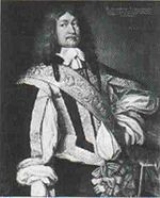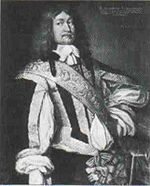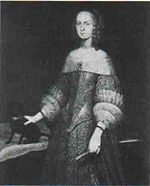
Duke of Augustenborg
Encyclopedia
The House of Schleswig-Holstein-Sonderburg-Augustenburg was a branch of the dukes of Schleswig-Holstein-Sonderburg
of the House of Oldenburg
. The line descended from Alexander, Duke of Schleswig-Holstein-Sonderburg. Like all the secondary lines from the Sonderburg branch, the heads of the House of Schleswig-Holstein-Sonderburg-Augustenburg were first known as Dukes of Schleswig-Holstein and Dukes of Sonderburg. The family took its name from its ancestral home, Augustenborg Palace, in Augustenborg, Denmark
.

 The branch originated from Ernest Gunther, a member of the ducal House of Schleswig-Holstein
The branch originated from Ernest Gunther, a member of the ducal House of Schleswig-Holstein
(its branch of Sønderborg
) and a cadet of the royal house of Denmark, the third son of Alexander
(1573-1627), 2nd Duke of Sonderborg, thus a grandson of duke Hans
(1545-1622), the 1st duke, who was a son of King Christian III
.
Ernest Gunther had a castle built in the years after 1651, which received the name Augustenborg in honor of his wife, Auguste, herself also from a branch of Dukes of Schleswig-Holstein, daughter of Philip (1584-1663), Duke of Glucksburg. As that castle became the chief seat of their line, the line eventually used the name Augustenborg as its branch name. As they were agnates
of the ducal house, the title of Duke belonged to everyone of them (as is the Germanic custom).
The Dukes of Augustenborg were not sovereign rulers — they held their lands in fief to the sovereign Dukes of Schleswig
and Holstein
- the Kings of Denmark.
Later, a Danish king made the head of that line specifically Duke of Augustenborg. In the late 18th century, since 1764, the branch of Slesvig-Holsten-Sønderborg-Augustenborg was genealogically the next senior immediately after the main line of Danish kings, and had much Danish nobility blood in their veins. King Frederick VI of Denmark
, or rather his chief adviser Andreas Peter Bernstorff
, made his only sister Louise Auguste of Denmark
to marry the then Hereditary Prince of Augustenborg
.
In 1764 Sønderborg castle
, the seat of that elder Schleswig-Holstein branch, passed upon its extinction into the hands of the Duke of Augustenborg, but against expectations it did not became a residence (they remained at Augustenborg). Instead it was rented out as a warehouse. The penultimate Duke of Augustenborg, also named Ernst Günther, allowed Sønderborg County Museum to move into a part of the castle in 1920. The next year the Danish state bought the castle from the Duke.
In 1810, a younger scion of the family, Prince Christian August, was chosen as the Crown Prince of Sweden, and adopted by king Charles XIII of Sweden
. The Augustenborg dynasty on a royal throne was however not to be actualized, as Prince Christian August died just in a couple of months after his arrival in Sweden.
In the early 19th century the Danish royal line started to go extinct. The Duke of Augustenborg was the next male-line heir to the royal house, though not descended in male line from Frederick III of Denmark and Norway. This made the duke a player in the convoluted Schleswig-Holstein Question
, as well in the Danish succession. Frederik August of Augustenborg attempted to proclaim himself as Duke Frederick VIII of Schleswig-Holstein in 1864 upon the final extinction of the main branch, Danish kings.
His daughter Augusta Victoria of Schleswig-Holstein became German Empress as consort of Wilhelm II.
The ducal line died out in 1931. In November 1920 its penultimate head had adopted Prince Johann Georg of Schleswig-Holstein-Sonderburg-Glücksburg and his sister Princess Marie Luise, children of Prince Albrecht of Schleswig-Holstein-Sonderburg-Glücksburg
. After Augustenborg's extinction in 1931, the senior status went to the line of Dukes of Glucksburg
, heads of the second line of Holstein, known in German as Schleswig-Holstein-Sonderburg-Glücksburg
and in Danish as Slesvig-Holsten-Sønderborg-Lyksborg.
Dukes of Schleswig-Holstein
Like the previous Oldenburg dynasty all previous monarchs of the Glücksburg dynasty in Denmark also claimed the titles as Dukes of Schleswig and Holstein. The current Danish monarch, Queen Margrethe II
abandoned this tradition upon ascending the Danish throne in 1972. The Glücksburg dynasty considered the two territories to be separate entities and it consequently never used the form "Schleswig-Holstein" in titles. The Russia
n Romanov
dynasty used the form "Schleswig-Holstein".
Schleswig-Holstein-Sonderburg
Schleswig-Holstein-Sonderburg was the name of a branch line of the House of Oldenburg as well as the name of their land. It existed from 1564 until 1668 and was a titular duchy under the King of Denmark, rather than a true territorial dukedom in its own right...
of the House of Oldenburg
House of Oldenburg
The House of Oldenburg is a North German dynasty and one of Europe's most influential Royal Houses with branches that rule or have ruled in Denmark, Russia, Greece, Norway, Schleswig, Holstein, Oldenburg and Sweden...
. The line descended from Alexander, Duke of Schleswig-Holstein-Sonderburg. Like all the secondary lines from the Sonderburg branch, the heads of the House of Schleswig-Holstein-Sonderburg-Augustenburg were first known as Dukes of Schleswig-Holstein and Dukes of Sonderburg. The family took its name from its ancestral home, Augustenborg Palace, in Augustenborg, Denmark
Denmark
Denmark is a Scandinavian country in Northern Europe. The countries of Denmark and Greenland, as well as the Faroe Islands, constitute the Kingdom of Denmark . It is the southernmost of the Nordic countries, southwest of Sweden and south of Norway, and bordered to the south by Germany. Denmark...
.
History


Schleswig-Holstein
Schleswig-Holstein is the northernmost of the sixteen states of Germany, comprising most of the historical duchy of Holstein and the southern part of the former Duchy of Schleswig...
(its branch of Sønderborg
Schleswig-Holstein-Sonderburg
Schleswig-Holstein-Sonderburg was the name of a branch line of the House of Oldenburg as well as the name of their land. It existed from 1564 until 1668 and was a titular duchy under the King of Denmark, rather than a true territorial dukedom in its own right...
) and a cadet of the royal house of Denmark, the third son of Alexander
Alexander, Duke of Sonderburg
Alexander, Duke of Schleswig-Holstein-Sonderburg , was a Danish nobleman.Alexander was born in Sønderborg in Schleswig, the third child of Johann II, Duke of Schleswig-Holstein-Sonderburg-Plon and Elisabeth of Brunswick-Grubenhagen...
(1573-1627), 2nd Duke of Sonderborg, thus a grandson of duke Hans
John II, Duke of Sonderburg
John II of Schleswig-Holstein-Sonderburg was a Duke of Schleswig-Holstein-Sonderburg.John was born in Haderslev as the fourth son of King Christian III of Denmark and his wife Dorothea of Saxe-Lauenburg. His elder brother king Frederick II of Denmark allotted him a portion of Schleswig, Sonderburg...
(1545-1622), the 1st duke, who was a son of King Christian III
Christian III of Denmark
Christian III reigned as king of Denmark and Norway. He was the eldest son of King Frederick I and Anna of Brandenburg.-Childhood:...
.
Ernest Gunther had a castle built in the years after 1651, which received the name Augustenborg in honor of his wife, Auguste, herself also from a branch of Dukes of Schleswig-Holstein, daughter of Philip (1584-1663), Duke of Glucksburg. As that castle became the chief seat of their line, the line eventually used the name Augustenborg as its branch name. As they were agnates
Patrilineality
Patrilineality is a system in which one belongs to one's father's lineage. It generally involves the inheritance of property, names or titles through the male line as well....
of the ducal house, the title of Duke belonged to everyone of them (as is the Germanic custom).
The Dukes of Augustenborg were not sovereign rulers — they held their lands in fief to the sovereign Dukes of Schleswig
Schleswig
Schleswig or South Jutland is a region covering the area about 60 km north and 70 km south of the border between Germany and Denmark; the territory has been divided between the two countries since 1920, with Northern Schleswig in Denmark and Southern Schleswig in Germany...
and Holstein
Holstein
Holstein is the region between the rivers Elbe and Eider. It is part of Schleswig-Holstein, the northernmost state of Germany....
- the Kings of Denmark.
Later, a Danish king made the head of that line specifically Duke of Augustenborg. In the late 18th century, since 1764, the branch of Slesvig-Holsten-Sønderborg-Augustenborg was genealogically the next senior immediately after the main line of Danish kings, and had much Danish nobility blood in their veins. King Frederick VI of Denmark
Frederick VI of Denmark
Frederick VI reigned as King of Denmark , and as king of Norway .-Regent of Denmark:Frederick's parents were King Christian VII and Caroline Matilda of Wales...
, or rather his chief adviser Andreas Peter Bernstorff
Andreas Peter Bernstorff
Andreas Peter Bernstorff was a Danish statesman and politician. He was a Danish minister, father of Christian Günther von Bernstorff, and a guardian of civil and political liberty.-Background and early career:A. P...
, made his only sister Louise Auguste of Denmark
Louise Auguste of Denmark
Louise Auguste of Denmark, Duchess of Augustenborg or Louise Augusta, was a Danish princess, officially daughter of King Christian VII of Denmark and Queen Caroline Mathilde...
to marry the then Hereditary Prince of Augustenborg
Frederik Christian II, Duke of Augustenborg
Frederick Christian II, Duke of Augustenborg was a Danish prince and feudal magnate...
.
In 1764 Sønderborg castle
Sønderborg Castle
Sønderborg Castle is located in the town of Sønderborg, Denmark on the island of Als in South Jutland. It houses a museum focusing on the history and culture of the area. The castle is located in the middle of the town, in a park setting overlooking Als Fjord...
, the seat of that elder Schleswig-Holstein branch, passed upon its extinction into the hands of the Duke of Augustenborg, but against expectations it did not became a residence (they remained at Augustenborg). Instead it was rented out as a warehouse. The penultimate Duke of Augustenborg, also named Ernst Günther, allowed Sønderborg County Museum to move into a part of the castle in 1920. The next year the Danish state bought the castle from the Duke.
In 1810, a younger scion of the family, Prince Christian August, was chosen as the Crown Prince of Sweden, and adopted by king Charles XIII of Sweden
Charles XIII of Sweden
Charles XIII & II also Carl, , was King of Sweden from 1809 and King of Norway from 1814 until his death...
. The Augustenborg dynasty on a royal throne was however not to be actualized, as Prince Christian August died just in a couple of months after his arrival in Sweden.
In the early 19th century the Danish royal line started to go extinct. The Duke of Augustenborg was the next male-line heir to the royal house, though not descended in male line from Frederick III of Denmark and Norway. This made the duke a player in the convoluted Schleswig-Holstein Question
Schleswig-Holstein Question
The Schleswig-Holstein Question was a complex of diplomatic and other issues arising in the 19th century from the relations of two duchies, Schleswig and Holstein , to the Danish crown and to the German Confederation....
, as well in the Danish succession. Frederik August of Augustenborg attempted to proclaim himself as Duke Frederick VIII of Schleswig-Holstein in 1864 upon the final extinction of the main branch, Danish kings.
His daughter Augusta Victoria of Schleswig-Holstein became German Empress as consort of Wilhelm II.
The ducal line died out in 1931. In November 1920 its penultimate head had adopted Prince Johann Georg of Schleswig-Holstein-Sonderburg-Glücksburg and his sister Princess Marie Luise, children of Prince Albrecht of Schleswig-Holstein-Sonderburg-Glücksburg
Prince Albrecht of Schleswig-Holstein-Sonderburg-Glücksburg
Prince Albrecht of Schleswig-Holstein-Sonderburg-Glücksburg was the fifth and youngest child of Friedrich, Duke of Schleswig-Holstein-Sonderburg-Glücksburg and his wife Princess Adelheid of Schaumburg-Lippe and was a nephew of Christian IX of Denmark...
. After Augustenborg's extinction in 1931, the senior status went to the line of Dukes of Glucksburg
Glücksburg
Glücksburg is a small town in the district Schleswig-Flensburg, in Schleswig-Holstein, Germany.It is situated on the south side of the Flensburg Fjord, an inlet of the Baltic Sea, approx. 10 km northeast of Flensburg...
, heads of the second line of Holstein, known in German as Schleswig-Holstein-Sonderburg-Glücksburg
Schleswig-Holstein-Sonderburg-Glücksburg
The House of Schleswig-Holstein-Sonderburg-Glücksburg , known as the House of Glücksburg for short, is a German ducal house, junior branches of which include the royal houses of Denmark and Norway, the deposed royal house of Greece, and the heir to the thrones of the Commonwealth realms The House...
and in Danish as Slesvig-Holsten-Sønderborg-Lyksborg.
List of Dukes
Dukes of Augustenborg- Ernest Günther, 1647-1689
- Frederik (1689-1692), son
- Ernest August (1692-1731), brother
- Christian August (1731-1754), nephew
- Frederik Christian I (1754-1794), son
- Frederik Christian II (1794-1814), son
- Christian August (1814-1869), son
Dukes of Schleswig-Holstein
- Frederik VIII August (1863-1880), son
- Frederick proclaimed himself Duke of Schleswig-HolsteinSchleswig-HolsteinSchleswig-Holstein is the northernmost of the sixteen states of Germany, comprising most of the historical duchy of Holstein and the southern part of the former Duchy of Schleswig...
in 1863 and was recognized by Prussia as equivalent of mediatized principalities.- Ernest GüntherErnst Gunther, Duke of Schleswig-HolsteinErnst Gunther, Duke of Schleswig-Holstein was a son of Frederick VIII, Duke of Schleswig-Holstein and Princess Adelheid of Hohenlohe-Langenburg. He inherited his father's title as titular duke of Schleswig-Holstein....
(1880-1921), son - AlbertAlbert, Duke of Schleswig-HolsteinPrince Albert, Duke of Schleswig-Holstein was a grandson of Queen Victoria of the United Kingdom. He was the second son of Victoria's daughter, Princess Helena, by her husband Prince Christian of Schleswig-Holstein...
(1921-1931), cousin
- Ernest Günther
Like the previous Oldenburg dynasty all previous monarchs of the Glücksburg dynasty in Denmark also claimed the titles as Dukes of Schleswig and Holstein. The current Danish monarch, Queen Margrethe II
Margrethe II of Denmark
Margrethe II is the Queen regnant of the Kingdom of Denmark. In 1972 she became the first female monarch of Denmark since Margaret I, ruler of the Scandinavian countries in 1375-1412 during the Kalmar Union.-Early life:...
abandoned this tradition upon ascending the Danish throne in 1972. The Glücksburg dynasty considered the two territories to be separate entities and it consequently never used the form "Schleswig-Holstein" in titles. The Russia
Russia
Russia or , officially known as both Russia and the Russian Federation , is a country in northern Eurasia. It is a federal semi-presidential republic, comprising 83 federal subjects...
n Romanov
Romanov
The House of Romanov was the second and last imperial dynasty to rule over Russia, reigning from 1613 until the February Revolution abolished the crown in 1917...
dynasty used the form "Schleswig-Holstein".

